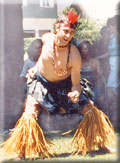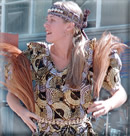Alokli - Traditional African Dances (original) (raw)
Alokli Dance Repertoire
Here's a little about the dance-drumming styles we perform. Also be sure to check out our audio clips and video clips.
The following text is also available in PDF format, which allows correct spelling of African text. To view PDF files you need Adobe Acrobat Reader installed on your computer - it's free.
![]() Dance Repertoire in PDF format (53 KB)
Dance Repertoire in PDF format (53 KB)
Major Historical Styles
 Adzohu (Ago, Atsia, Kadodo). An epic sacred & historical dance also known as Adzogbo. Dating from the early days of European occupation, Adzohu originally functioned as a spiritual preparation for war, but today it is more a cultural and social event. Dancers wear colorful waist cloth, ankle raffia, bells and hats. The songs build self-respect and strengthen cultural identity to counter the influence of contact with the West. A vast repertoire of movements depict battlefield cunning and bravery, among other things.
Adzohu (Ago, Atsia, Kadodo). An epic sacred & historical dance also known as Adzogbo. Dating from the early days of European occupation, Adzohu originally functioned as a spiritual preparation for war, but today it is more a cultural and social event. Dancers wear colorful waist cloth, ankle raffia, bells and hats. The songs build self-respect and strengthen cultural identity to counter the influence of contact with the West. A vast repertoire of movements depict battlefield cunning and bravery, among other things.
Agbekor (Vulolo, Vutsotsoe). An ancient Foh and Ewe war dance once known as Atamga. Agbekor is often performed at social/cultural events and at funerals. It is danced with horsetails and features spectacular slow and fast dance sections interspersed with many ritual song and movement interludes. Dance movements mimic battlefield tactics such as reconnaissance, surprise attack and hand to hand combat.
Cultural and Social Styles
Anyako Atsia. This popular circle dance from the Ewes of Anyako features songs about morality, community, character, and pride. The event is primarily social, and a chance for people to express themselves (and even flirt a bit) through dance & song.
 Togo Atsia. A subtle and stylish women's dance from the Ewes of Togo. This event is traditionally organized by women and is used to present their point of view on social issues to the community. Dance and music interludes are interwoven with short skits that focus on the challenges of modern life (often the issues between men & women in particular). Dancers use two horsetails for most movements.
Togo Atsia. A subtle and stylish women's dance from the Ewes of Togo. This event is traditionally organized by women and is used to present their point of view on social issues to the community. Dance and music interludes are interwoven with short skits that focus on the challenges of modern life (often the issues between men & women in particular). Dancers use two horsetails for most movements.
NanDom Bawa. A harvest celebration/prayer/thanksgiving dance from the Lobi people of northwestern Ghana. For practical reasons we don't incorporate baliphones (marimbas) and some other traditional instruments into our performances, which is a big departure from traditional practice - but there's so much going on that it's still a great show piece.
Gahu. A colorful circle dance originally from Nigeria. Dancers wear expensive robes and headgear, and sing of being well-off and proud of it. Gahu seems to enjoy poking fun at Europeans and their odd behavior, among other things.
Tokoe. A coming-of-age dance for girls among the Ga-Adangme, learned at puberty along with mothercraft. Simple but stylish movements present the newly eligible girls to the community.
Kinka. Lively social music and dance derived from older sacred traditions - all of the fun but none of the heavy religious overtones. We usually involve our audience in this one. Traditionally Kinka features songs that are especially well crafted and usually political.
Kpanlogo. A fairly recent (1940s?) highlife dance form. Dancing is high-spirited and the songs are fresh and lively. The drums are conga-like and played with hands.
Agbadza (Poka, Ageshe). A major Ewe social dance tradition. The lead is played on sogo with the hands resulting in a unique musical texture. Slow and fast sections.
Ahazevu Vulolo. A slow social dance tradition. What we do is a small representation of a large musical heritage whose primary purpose is dance fellowship.
Brekete. Ewe music and social dance featuring the buzzing cylindrical Brekete drum.
Gadzo. Both a political and spiritual dance, Gadzo was banned by the British during early colonization because it was perceived as an incendiary institution. Feverish music and dance performed traditionally with live swords (we use fake ones) makes this an exciting event. Drums are conga-like and played with hands.
Takada. A women's social event among the Ewes. The songs build pride and power among women and warn the community of men to make way for other points of view. Historically Takada is associated with a time about 50 years ago when women all over the world began demanding equal standing with men.
Yeve Ritual Music
Agovu. As the name implies, this slower music respectfully "knocks at the door" of the ancestral spirit world to ask for admittance.
Sovu. Dynamic music of spiritual consecration used to clear away material distractions in preparation for worship & possession. We combine several episodes from this style into a consecutive suite of dance segments to make an exciting performance piece.
Adavu/Afovu. Two powerful possession and worship musics that we often perform together as a suite. Any explanation of this music falls short of the actually experience, so give it a listen and you try to describe it!
Sogba. Social dance music, probably heard more than any other style because it allows for relaxed social fellowship and song.
Husago. Distinctive sacred music of a deeply polyrhythmic nature. Husago is used as an introductory music to Yeve ceremonies, also common at funerals.
Fofui. Music associated with healing and vitality. Highly energetic dancing set to some very fast and intricate music.
Other Sacred Styles
Afa (Anago, Dzisa). Music and dance from Afa, a religious sect. Afa initiates go through a long initiation period like the Yeve, but Afa music is less exclusive and lends itself readily to secular events. Afa is often performed before other dance styles to consecrate an event, something like saying a prayer before a baseball game.